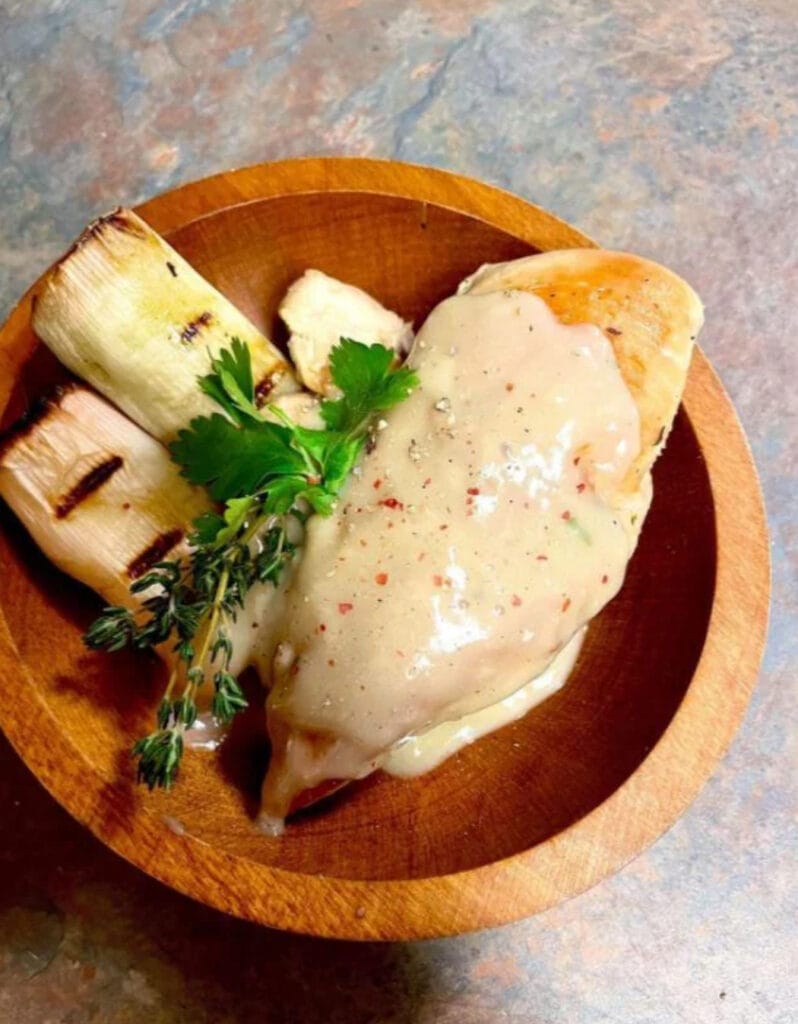Credit: Scholasticus_

Recipe (Apicius 6.8.11):
“pullum quoques iure hoc: liquamine oleo uino fasciculum porri coriandri satureiae: cum coctus fuerit teres piper; nucleos ciatos duos et ius de suo sibi subfundis et fasciculos proicies. lac temperas et reexaminaies [in] mortarium supra pullum, ut ferueat. obligas eundem aluamentis ouorum tritis, ponis in lance et iure supra scripto perfundis. hoc ius candidum appellatur.”
“Cook the chicken with this sauce: a bundle of leek, coriander and savory, in liquamen, oil, and wine; when it is cooked, pound pepper, two cups of pine nuts, and pour on the cooking liquor and discard the bundle. Blend with milk and pour the contents of the mortar over the chicken and bring it to heat. Thicken it with beaten white of egg. Place the chicken on a serving dish and pour the sauce written above over it. This is called a white sauce.”
___________________________________________________________
So, this recipe is obviously lacking in precision, especially in what Apicius refers to as a ‘white sauce’. As a result, my approach to this dish was an experiment! I should also add that some of these ingredients were not available to me, so I used the following replacements:
In place of savory (which I was unable to get my hands on), I used thyme (which was actually familiar to the Romans).
In place of liquamen (a type of fermented fish sauce), I used an east-Asian fish sauce. I used less fish sauce than perhaps the Romans may have used of liquamen.
In order to make the white sauce, I opted for a white wine.
Due to allergies, my white sauce was made using oat milk rather than another sort of milk (likely dairy milk, although the Latin doesn’t specify!).
These are the rough measurements I used:
1 Leek, cut up.
1 Small bundle of coriander.
1 small bundle of thyme (in place of savory).
Splash of fish sauce (in place of liquamen).
3 cups of white wine.
Generous splash of olive oil.
Generous pinch of black pepper, ground.
A couple tablespoons of pine nuts (for the portion which I was making, this worked well), ground.
1 cup of milk.
1 egg white.
Chicken: I used chicken breast (2-3).
_________________________________________________________
To start the sauce, I brought the wine, oil, and fish oil up to boil with the leek, coriander, and thyme. Let this boil off for 5-10 minutes, then add the ground pepper, pine nuts, and milk. Stir this in and add the raw chicken. Cover, and allow for the chicken to cook in the sauce. Cook until the chicken reached an internal temperature of 160 F and remove. Then, cross referencing from Apicius 6.8.12 (Frontonian Chicken), I seared the chicken, ensuring that the internal temperature came to at least 165 F. If you do not want to incorporate this emendation, ensure that the chicken cooks in the sauce to 165 F. Once the chicken is removed, lower the temperature dramatically (such that it is not boiling), and add the egg white. Stir the egg white actively into the sauce and allow it to slowly cook in. I have found that if you add the egg white while the sauce is too hot, it will clump!
I decided to serve this with grilled leeks, and then the sauce is served of the chicken (I’ve garnished here with a bit of coriander, thyme, and pepper).
I find it interesting that egg whites are used to thicken the sauce, rather than a flour (which would have been used in other circumstances). The result was a very rich sauce which paired very well with the chicken (and leeks)! I hope you enjoy!
